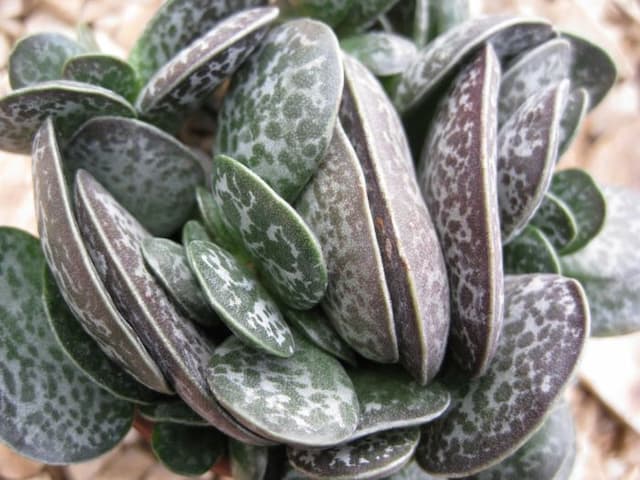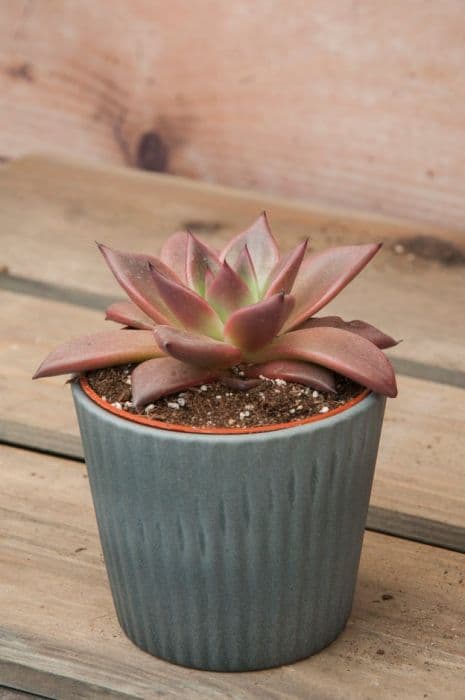Pig's Ear Cotyledon orbiculata











ABOUT
The plant, commonly known as Pig's Ear, is an attractive succulent with fleshy, rounded leaves that are often gray-green in color. The leaves can have a red line around the edges, especially when exposed to sunlight. They are thick and feel rubbery to the touch, being able to retain water to endure dry conditions. The surface of the leaves may appear powdery due to a waxy coating which helps reduce water loss. Pig's Ear produces bell-shaped flowers on tall stems, which are usually orange to red in color, adding to the decorative appeal of this succulent. The blooms can be quite striking, standing out against the fleshy leaves. The overall appearance of Pig's Ear is of a robust and drought-tolerant plant that has adapted well to arid environments with its water-storing leaves and striking flowers.
About this plant
 Names
NamesFamily
Crassulaceae
Synonyms
Pig's Ear, Round-leafed Navel-wort, Round-leaved Cotyledon
Common names
Cotyledon orbiculata var. oblonga Haw., Cotyledon orbiculata var. spuria (Haw.) Toelken, Cotyledon oblonga (Haw.) Haw., Cotyledon spuria Haw., Cotyledon oblonga f. caulescens Poelln., Cotyledon orbiculata var. dactylopsis Toelken.
 Toxicity
ToxicityTo humans
Pig's Ear is known to be toxic if ingested. The toxicity is due to compounds such as cardiac glycosides which, when ingested, can lead to symptoms such as nausea, vomiting, diarrhea, and in severe cases, heart irregularities, and it can be potentially life-threatening if consumed in large quantities. Care should be taken to avoid eating any part of this plant.
To pets
Pig's Ear is also toxic to animals such as cats and dogs. The toxic compounds, cardiac glycosides, can cause similar symptoms in pets as in humans, including vomiting, diarrhea, and possibly cardiac issues. If a pet ingests part of this plant, immediate veterinary attention may be necessary to prevent serious health consequences or death. It is prudent to keep this plant out of reach of pets.
 Characteristics
CharacteristicsLife cycle
Perennials
Foliage type
Evergreen
Color of leaves
Varies
Flower color
Orange
Height
2 feet (0.6 meters)
Spread
2 feet (0.6 meters)
Plant type
Succulent
Hardiness zones
9
Native area
South Africa
Benefits
 General Benefits
General Benefits- Drought Tolerance: Pig's Ear has a high tolerance for dry conditions, making it suitable for xeriscaping and water-wise gardens.
- Low Maintenance: It requires minimal care, making it an excellent choice for busy gardeners or those seeking low-maintenance landscapes.
- Attractive Foliage: Pig's Ear has succulent leaves that are visually appealing and can add texture and color contrast to garden designs.
- Easy Propagation: The plant can easily be propagated from leaves or cuttings, allowing gardeners to create more plants without additional cost.
- Pest Resistance: Pig's Ear is relatively resistant to pests, reducing the need for chemical treatments.
- Adaptability: It can adapt to a variety of soil types, although it prefers well-draining soil.
- Long Blooming Period: The plant produces attractive bell-shaped flowers that can last for several months, providing extended visual interest.
- Climate Resilience: Pig's Ear is capable of withstanding varying temperatures and is relatively frost hardy for a succulent.
- Outdoor and Indoor Use: It can be grown both outdoors in rockeries and drought-tolerant landscapes, as well as indoors in containers.
 Medical Properties
Medical Properties- Treatment of warts: The sap of Cotyledon orbiculata has been traditionally used for the topical treatment of warts.
- Skin ailments: The plant's sap is also popularly applied to corns and calluses for its supposed skin healing properties.
- Antimicrobial effects: Some studies suggest that extracts from the plant may have antimicrobial properties against certain pathogens.
- Anti-inflammatory properties: The plant is thought to have anti-inflammatory effects, which might be beneficial in reducing inflammation when applied topically.
 Air-purifying Qualities
Air-purifying QualitiesThis plant is not specifically known for air purifying qualities.
 Other Uses
Other Uses- Cotyledon orbiculata, commonly known as Pig's Ear, can be used in rock gardens for its interesting leaf shapes and colors, adding texture and variety to the garden design.
- The plant can be incorporated into green roofs or living roofs, where its drought tolerance makes it a good candidate for these water-wise plantings.
- Pig's Ear can be used in xeriscaping, a landscaping method that reduces the need for irrigation, making it ideal for arid and semi-arid climates.
- The thick leaves can be used in floral arrangements to add succulent texture and a glaucous hue that contrasts well with different flowers.
- Cotyledon orbiculata's leaves are sometimes used to line hanging baskets, providing a supportive base for other plants to grow on.
- Their sculptural form can be used as a natural art piece, contributing to the aesthetic of a succulent collection in both indoor and outdoor settings.
- As an educational tool, Cotyledon orbiculata can be used to demonstrate water storage strategies in plants, showing how succulents survive in dry conditions.
- The sap of Pig's Ear has been historically used as a corn and wart remover, although this is not a recommended practice due to potential skin irritation.
- In mild climates, Pig's Ear can be grown as a ground cover, providing a low-maintenance and drought-resilient mat over the soil.
- The unique shape of the plant makes it a good option for container gardens, where its rosette form can be displayed prominently among other potted plants.
Interesting Facts
 Feng Shui
Feng ShuiThe Pig's Ear is not used in Feng Shui practice.
 Zodiac Sign Compitability
Zodiac Sign CompitabilityThe Pig's Ear is not used in astrology practice.
 Plant Symbolism
Plant Symbolism- Longevity: The Cotyledon orbiculata, commonly known as Pig's Ear, is a succulent plant that can survive in harsh conditions due to its ability to retain water. This feature symbolizes endurance and the ability to thrive over time.
- Prosperity: Succulents like Pig's Ear are often associated with wealth and abundance because of their plump, rich-looking leaves and their propensity to produce offsets, which can be seen as a form of multiplication of resources.
- Protection: Pig's Ear has thick leaves that can feel somewhat rubbery or leathery. This physical trait symbolizes a protective barrier, representing safety and shelter.
- Adaptability: As a succulent, Pig's Ear is able to adapt to various environmental challenges, symbolizing flexibility and the ability to adjust to varying circumstances in life.
 Water
WaterPig's Ear should be watered sparingly, as it is a succulent plant that prefers dry conditions. Generally, it is best to water thoroughly once every two weeks during the active growing season, which is spring through fall. In the winter, water only enough to prevent the leaves from shriveling, which may mean cutting back to once a month or less. When watering, apply water directly to the soil and avoid getting the leaves wet to prevent rot. Allow the soil to dry out completely between waterings. A good rule of thumb is to provide around 8-16 ounces of water per plant for each watering, depending on the size of the pot and the indoor climate.
 Light
LightPig's Ear thrives in bright, indirect light but can also tolerate direct sunlight, especially in the morning. The best spot for this succulent is near a south or west-facing window where it will receive ample light without the harsh midday sun. Avoid placing it in low light conditions, as this can cause the plant to become leggy and lose its compact shape. For optimal growth, ensure it gets at least 4-6 hours of sunlight every day.
 Temperature
TemperaturePig's Ear prefers a warm and dry environment, with ideal temperatures ranging between 60°F and 85°F. It can withstand temperatures as low as 30°F but should be protected from frost. Avoid drastic temperature fluctuations and drafty areas, as this can stress the plant. Keeping the plant within this temperature range will help ensure that its succulent leaves remain plump and healthy.
 Pruning
PruningPig's Ear should be pruned to maintain its shape, remove any damaged or dead leaves, and encourage bushier growth. Pruning is best done in the spring or early summer at the beginning of the growing season. Cut back any leggy growth to promote a fuller plant. Remove spent flowers to keep the plant looking tidy and redirect energy to new growth. Pruning once a year is typically sufficient for keeping Pig's Ear in optimal condition.
 Cleaning
CleaningAs needed
 Soil
SoilThe Pig's Ear needs well-draining soil with sandy or gritty components to prevent root rot. A succulent or cactus mix, amended with perlite or pumice for extra drainage, works well. The ideal soil pH for Pig's Ear ranges from 6.0 to 7.5.
 Repotting
RepottingPig's Ear should be repotted every 2 to 3 years or when it outgrows its current pot. Use fresh succulent soil mix and a pot just slightly larger than the previous one.
 Humidity & Misting
Humidity & MistingPig's Ear prefers low humidity environments, typical of arid and semi-arid regions.
 Suitable locations
Suitable locationsIndoor
Grow Pig's Ear in bright light with some direct sun.
Outdoor
Plant Pig's Ear in full sun to light shade areas.
Hardiness zone
9-11 USDA
 Life cycle
Life cycleCotyledon orbiculata, commonly known as Pig's Ear, begins its life cycle as a seed that germinates in favorable conditions which typically include well-drained soil and warm temperatures. Once germinated, the seedling grows into a succulent plant with fleshy, oval leaves and a thick stem that helps retain water. The plant undergoes vegetative growth, developing a rosette of leaves at ground level. After a few years, when mature, it produces tall flowering stalks bearing bell-shaped flowers, usually orange to red in color, which attract pollinators. Following pollination and fertilization, seeds are formed and dispersed, completing the reproductive phase. The parent plant may die after flowering and setting seeds, or it may continue to grow and produce flowers seasonally.
 Propogation
PropogationPropogation time
Spring-Early Summer
The Pig's Ear (Cotyledon orbiculata) can be propagated effectively through leaf cuttings, which is the most popular method. To do this, select a healthy, mature leaf from the parent plant and gently twist it off ensuring that you have a clean pull with no part of the leaf left on the stem. Allow the leaf to callous for a few days in a warm, dry location away from direct sunlight, which helps prevent rot when planted. Once calloused, place the leaf on top of a well-draining cactus or succulent soil mix, barely burying the cut end in the soil. Water sparingly, providing just enough moisture to keep the soil slightly damp; excessive water can cause the leaf to rot. Roots and a new plantlet should emerge from the base of the leaf in a few weeks to a few months, at which point it can be treated as a new plant.









